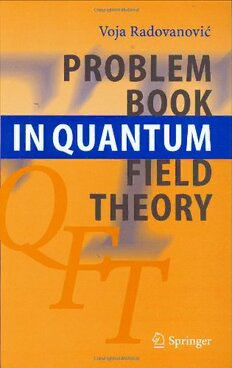
Problem Book in Quantum Field Theory PDF
Preview Problem Book in Quantum Field Theory
ProblemBookQuantumFieldTheory Voja Radovanovic Problem Book Quantum Field Theory ABC VojaRadovanovic FacultyofPhysics UniversityofBelgrade Studentskitrg12-16 11000Belgrade Yugoslavia LibraryofCongressControlNumber:2005934040 ISBN-10 3-540-29062-1SpringerBerlinHeidelbergNewYork ISBN-13 978-3-540-29062-9SpringerBerlinHeidelbergNewYork Thisworkissubjecttocopyright.Allrightsarereserved,whetherthewholeorpartofthematerialis concerned,specificallytherightsoftranslation,reprinting,reuseofillustrations,recitation,broadcasting, reproductiononmicrofilmorinanyotherway,andstorageindatabanks.Duplicationofthispublication orpartsthereofispermittedonlyundertheprovisionsoftheGermanCopyrightLawofSeptember9, 1965,initscurrentversion,andpermissionforusemustalwaysbeobtainedfromSpringer.Violationsare liableforprosecutionundertheGermanCopyrightLaw. SpringerisapartofSpringerScience+BusinessMedia springeronline.com (cid:1)c Springer-VerlagBerlinHeidelberg2006 PrintedinTheNetherlands Theuseofgeneraldescriptivenames,registerednames,trademarks,etc.inthispublicationdoesnotimply, evenintheabsenceofaspecificstatement,thatsuchnamesareexemptfromtherelevantprotectivelaws andregulationsandthereforefreeforgeneraluse. Typesetting:bytheauthorandTechBooksusingaSpringerLATEXmacropackage Coverdesign:design&productionGmbH,Heidelberg Printedonacid-freepaper SPIN:11544920 56/TechBooks 543210 To my daughter Natalija Preface This Problem Book is based on the exercises and lectures which I have given to undergraduate and graduate students of the Faculty of Physics, University of Belgrade over many years. Nowadays, there are a lot of excellent Quantum Field Theory textbooks. Unfortunately, there is a shortage of Problem Books inthisfield,oneoftheexceptionsbeingtheProblemBookofChengandLi[7]. The overlap between this Problem Book and [7] is very small, since the latter mostly deals with gauge field theory and particle physics. Textbooks usually contain problems without solutions. As in other areas of physics doing more problems in full details improves both understanding and efficiency. So, I feel that the absence of such a book in Quantum Field Theory is a gap in the literature. This was my main motivation for writing this Problem Book. To students: You cannot start to do problems without previous study- ing your lecture notes and textbooks. Try to solve problems without using solutions; they should help you to check your results. The level of this Prob- lem Book corresponds to the textbooks of Mandl and Show [15]; Greiner and Reinhardt [11] and Peskin and Schroeder [16]. Each Chapter begins with a short introduction aimed to define notation. The first Chapter is devoted to theLorentzandPoincar´e symmetries.Chapters2,3and4dealwiththerela- tivisticquantummechanicswithaspecialemphasisontheDiracequation.In Chapter 5 we present problems related to the Euler-Lagrange equations and the Noether theorem. The following Chapters concern the canonical quanti- zation of scalar, Dirac and electromagnetic fields. In Chapter 10 we consider tree level processes, while the last Chapter deals with renormalization and regularization. There are many colleagues whom I would like to thank for their support and help. Professors Milutin Blagojevi´c and Maja Buri´c gave many useful ideasconcerningproblemsandsolutions.IamgratefultotheAssistantsatthe Faculty of Physics, University of Belgrade: Marija Dimitrijevi´c, Duˇsko Latas and Antun Balaˇz who checked many of the solutions. Duˇsko Latas also drew all the figures in the Problem Book. I would like to mention the contribution of the students: Branislav Cvetkovi´c, Bojan Nikoli´c, Mihailo Vanevi´c, Marko VIII Preface Vojinovi´c, Aleksandra Stojakovi´c, Boris Grbi´c, Igor Salom, Irena Kneˇzevi´c, Zoran Ristivojevi´c and Vladimir Juriˇci´c. Branislav Cvetkovi´c, Maja Buri´c, MilutinBlagojevi´candDejanStojkovi´chavecorrectedmyEnglishtranslation of the Problem Book. I thank them all, but it goes without saying that all the errors that have crept in are my own. I would be grateful for any readers’ comments. Belgrade, August 2005 Voja Radovanovi´c Contents Part I Problems 1 Lorentz and Poincar´e symmetries.......................... 3 2 The Klein–Gordon equation ............................... 9 3 The γ–matrices............................................ 13 4 The Dirac equation ........................................ 17 5 Classical field theory and symmetries ..................... 25 6 Green functions ........................................... 31 7 Canonical quantization of the scalar field .................. 35 8 Canonical quantization of the Dirac field .................. 43 9 Canonical quantization of the electromagnetic field ........ 49 10 Processes in the lowest order of perturbation theory....... 55 11 Renormalization and regularization........................ 61 Part II Solutions 1 Lorentz and Poincar´e symmetries.......................... 67 2 The Klein–Gordon equation ............................... 77 3 The γ–matrices............................................ 85 X Contents 4 The Dirac equation ........................................ 93 5 Classical fields and symmetries ............................121 6 Green functions ...........................................131 7 Canonical quantization of the scalar field .................141 8 Canonical quantization of the Dirac field ..................161 9 Canonical quantization of the electromagnetic field ........179 10 Processes in the lowest order of the perturbation theory...191 11 Renormalization and regularization........................211 References.....................................................239 Index..........................................................241 Part I Problems 1 Lorentz and Poincar´e symmetries • Minkowski space, M is a real 4-dimensional vector space with metric tensor 4 defined by 1 0 0 0 0 −1 0 0 g = . (1.A) µν 0 0 −1 0 0 0 0 −1 Vectors can be written in the form x=xµe , where xµ are the contravariant µ components of the vector x in the basis 1 0 0 0 0 1 0 0 e = , e = , e = , e = . 0 0 1 0 2 1 3 0 0 0 0 1 The square of the length of a vector in M is x2 = g xµxν. The square of 4 µν the line element between two neighboring points xµ and xµ+dxµ takes the form ds2 =g dxµdxν =c2dt2−dx2. (1.B) µν The space M is also a manifold; xµ are global (inertial) coordinates. The 4 covariant components of a vector are defined by x =g xν. µ µν • Lorentz transformations, x(cid:1)µ =Λµ xν, (1.C) ν leavethesquareofthelengthofavectorinvariant,i.e.x(cid:1)2 =x2.ThematrixΛ isaconstantmatrix1;xµ andx(cid:1)µ arethecoordinatesofthesameeventintwo different inertial frames. In Problem 1.1 we shall show that from the previous definition it follows that the matrix Λ must satisfy the condition ΛTgΛ = g. The transformation law of the covariant components is given by x(cid:1) =(Λ−1)ν x =Λ νx . (1.D) µ µ ν µ ν 1 The first index in Λµ is the row index, the second index the column index. ν
